Delivering ideal crop nutrition throughout the growing season is a challenge. While it takes time and finesse, focusing on more effective rates and timing of micronutrient delivery is proving to be a profitable next step in fertility management for many growers.
“We’ve seen a substantial increase in use of micronutrients over the past five years,” says Shane Johnson, vice president of agronomy operations for United Cooperative, based in Beaver Dam, Wis. “For many Wisconsin growers, the primary increase has been on corn acres, but we’ve also seen more fine-tuning of micronutrient use on soybeans and alfalfa. About two-thirds of our growers now use a foliar fertilizer application on soybeans.
“Every set of soil samples we pull now has a full nutrient analysis, including micronutrients,” he says. “It has become standard, so growers expect it and most are paying more attention to micros in their fertility plans.”
Being able to fine-tune micronutrient use throughout the season requires taking the next sampling step: intensive tissue testing. “We encourage growers to start with their top-tier fields — those with the most yield potential — and pull tissue samples every two weeks during key growth and reproductive stages,” says Eric Smith, agronomist and northern sales lead for United Cooperative in the east-central part of the state.
Smith, who also operates and runs trials on his family’s 800-acre farm near Fremont, Wis., says testing is an investment, but one that usually produces significant returns.
“Growers in this region often have a wide variety of soil types across their acres, sometimes even within a field, so it’s important to collect data that helps build a catalog of agronomic information about how crops perform on each field. Plant tissue testing is another layer of information we can utilize within a season and over a three- to five-year span to help fine-tune crop nutrient plans for the next year.”
Start with zinc
The first micronutrient Smith typically has growers focus on is zinc. “We include zinc in all of our starter fertilizers and in sidedress applications based on tissue sampling results.”
Zinc is a common element in most starter fertilizers for corn because it aids in synthesizing enzymes that drive plant growth, especially in cool, early-season soils.
High levels of phosphorus can interfere with zinc uptake in the plant, especially on heavier clay soils, says Smith, so it may be necessary to increase zinc rates and vary application timing based on tissue sample results.
“In some cases, we’ve pulled zinc out of the sidedress application and added it to the starter because blending can be difficult at the farm site. Using 9% fully chelated zinc gives us more flexibility and easier mixing, while increasing plant uptake.”
Manage magnesium
In corn, adequate magnesium is essential for photosynthesis, as well as water use efficiency that supports heat and drought tolerance and late-season kernel fill, notes Smith.
“My agronomy counterpart Scott Firlus and I had an ‘aha’ moment with magnesium five years ago, when we started tissue sampling for it and realized the huge ROI that was possible from supplemental applications,” he adds. “We commonly saw an increase of 9 to 11 bushels per acre in cornfields that got additional in-season magnesium, with 1- to 1½-pounds-per-bushel heavier test weights.”
Magnesium retention depends on the soil’s cation-exchange capacity and is held on clay particles in the soil, so bigger yield responses are more common on irrigated acres and sandy soils with less organic matter, he says.

Get better with boron
Boron is essential for plant cell wall structure, root growth and pollination. For corn, it’s especially critical during tasseling and silking to drive flowering and grain fill. “We now usually recommend sidedressing boron at 1 to 2 quarts per acre and another quart with a later fungicide application,” says Smith. “Our field trials show a 2- to 4-bushel yield increase from in-season applications.”
Because boron is so mobile in soil, he recommends plant tissue analysis timed around rainfall events and reproductive states.
Calcium can be key
Adequate calcium levels are not always met, especially for soybean and alfalfa production, Smith says. Calcium is needed for cell wall strength and helps protect against fungal diseases such as white mold. “Later-season application of calcium and potash help preserve plant health by reducing disease issues.” He adds providing enough calcium in multiple applications is essential for intensively managed alfalfa fields.

Find sulfur solutions
Sulfur is often grouped with micronutrients, but Johnson notes it has become the fourth major nutrient as crop needs increased with the decrease in sulfur dioxide emissions from U.S. power plants and vehicles.
“Where 10 to 15 pounds of sulfur per acre used to be enough for corn crops here, we’re now applying 30 to 50 pounds of sulfur per acre per season. Some is fall-applied elemental sulfur and some is in the form of calcium sulfate or ammonium sulfate, typically applied in the spring.
“For alfalfa production, staying on top of sulfur levels is huge,” Johnson notes, “especially when you’re managing to maximize cuttings and yield.”
Plains plan for more micronutrients in soil
On the Kansas plains, where most growers cover thousands of acres, speed is of the essence in spring.
“Our customers want to get crops planted quickly to take advantage of spring moisture,” says Heath Labor, agronomy strategic account manager for Mid-West Fertilizer in eastern Kansas. “We were using more starter fertilizers on corn here but are shifting to more fall application of sulfur and zinc with dry macros. About 60% of our growers have some type of micronutrients plan and that number is growing because they’re seeing economic returns.”
To make that shift possible, Mid-West Fertilizer has upgraded its variable-rate application equipment, adding more bins for micronutrients on each rig. “With more hybrids now tailored to our drier conditions, it makes economic sense for growers to take a more tailored approach to micronutrient use, primarily zinc and sulfur.”
Yates Center, Kan., grower Caden Cummings is convinced. Over the past decade, he has transitioned more of his family’s 3,500-acre operation from wheat and milo to corn and soybeans. Early on, a friend in the seed business convinced him of the value of soil sampling on a regular basis.
“We started applying elemental sulfur in the fall and ammonium sulfate in the spring, and paying more attention to zinc,” he says. “It quickly became obvious that where zinc was out of whack, our yields were noticeably lower. Now our corn acres get additional zinc in a sidedress application, and we’ve added it to the starter because blending can be difficult at the farm site. On soybeans we make a mid-season application of sulfur and zinc with potassium, and we’re looking at upping the frequency of sulfur applications throughout the growing season.”
Yield increases have been consistent and substantial, he notes. “Eight to 10 years ago, our corn yields were in the 100- to 120-bushel range in a good year. Now we typically see 150- to 180-bushel yields, sometimes up to 200 bushels.”
The business includes 1,500 acres of native grasses, baled and sold to dairies and beef cattle operations from Michigan to Texas. Cummings says more closely managing fertility on those acres, namely increasing sulfur rates, has improved nitrogen uptake and boosted grass yields by 20% to 30%.
“Improving soil fertility and crop nutrition has involved changing our mentality to a ‘We can do this’ attitude about increasing yields,” he says. “We just had to start paying attention to the small things.”
When it comes to mastering micronutrient use, both Smith and Cummings say they’re about two-thirds of the way there.
“The last third will probably be less about needing additional micronutrients and more about delivery timing,” says Smith.
Micronutrient market challenges
As demand for micronutrients increases, sourcing some could become more complicated. “Experiences during the COVID-19 pandemic provided insights into how supply chain disruptions could negatively impact affordability and supply,” notes Anna Adams, CHS micronutrients product line lead.
She offers a look at factors that could influence 2024 sourcing for key micronutrients.
Boron
Global sources are limited, with the most deposits in Turkey (70%), the United States, South America, China and Russia. Boron is used in textiles, medicine, electronics and metallurgy, and to make glass, ceramics, detergents and flame retardants. Lack of suitable substitutes helps fuel global demand.
Price outlook: Stable to higher.
Zinc
The largest deposits are in Australia, Canada, China, Peru, Mexico and the U.S. Zinc dominates micronutrient markets for plant and animal production, but is also used in construction, vehicles, pharmaceuticals and textiles. Global zinc supplies were tight in 2023, following annual production deficits in 2021 and 2022. So far in 2024, global supply is outpacing the rebound in demand.
Price outlook: Stable to lower.
Manganese
With major deposits in South Africa, China, Australia and Brazil, manganese is an important raw material for the steel industry and has growing applications as a component of batteries. Prices have been trending downward due to lower steel production, but that’s expected to change in 2024, with reduced rail capacity and port delays in South Africa.
Price outlook: Stable to higher.
Sulfur
Molten sulfur is used to produce sulfuric acid, a critical raw material for fertilizers and mining. Subject to freight fluctuations, the Tampa molten sulfur index is expected to trade within its five-year average range in 2024.
Price outlook: Stable.
Check out the full Winter 2024 C magazine with this article and more.




